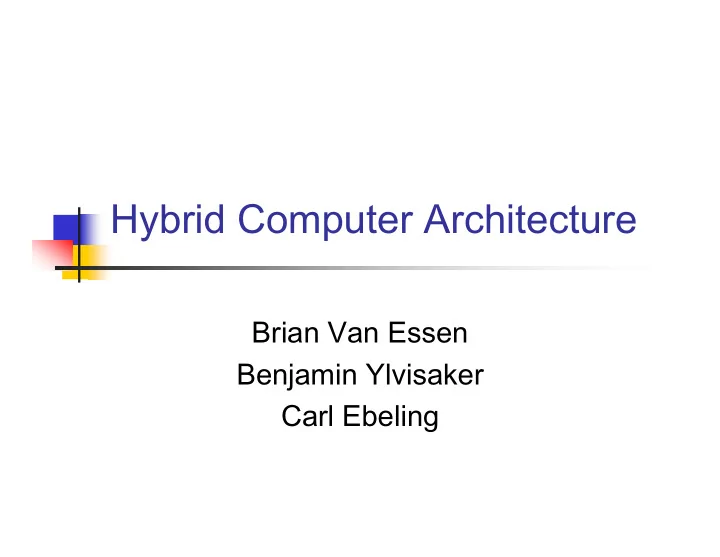

Hybrid Computer Architecture Brian Van Essen Benjamin Ylvisaker Carl Ebeling
Moore’s Law: Is it Over? n von Neumann processors no longer scale n Overhead of speculative execution is too high n Complexity of superscalar OOO core is n 2 n Optimum power / performance pipeline depth is ~7 stages n Spatial processors benefit from added transistors n Reconfigurability allows virtualization n Enables programming abstraction
Keeping up with streams is hard n Multimedia workloads n Audio & Video n Communication workloads n Networking Spatial processors are good at this ƒ(x)=… Example of a streaming transformation
Hybrid Architecture Research n Blend sequential and spatial computing n One program executes both types of computation
Overview n What is spatial computing n Why is it interesting n Hybrid Architectures n What is hard about hybrid architectures n Future Research
What is spatial computing? n Spatial processors: n Parallel array of compute elements (fabric) n Assign operations to different physical resources n Stream operands through the fabric n Execute many operations in parallel n Sequential processors: n Step through a sequence of instructions
Encoding a program Instruction Stream Dataflow Graph Load r 1 , A LD LD LD LD Load r 2 , B Load r 3 , C Load r 4 , D + x Add r 5 , r 1 , r 2 Mul r 6 , r 2 , r 3 Add r 7 , r 1 , r 5 + - Sub r 8 , r 5 , r 4 Sub r 9 , r 7 , r 6 Add r 10 , r 7 , r 8 - + x Mul r 11 , r 8 , r 4
Processors: Under the hood Traditional Computer Spatial Computer (Load / Store Arch) (e.g. FPGA, PipeRench) Data Instructions Fetch PE PE PE PE Memory Decode PE PE PE PE Execute ALU LS PE PE PE PE Register WriteBack File PE PE PE PE
Why spatial processors? n Extremely efficient for certain applications n Regular computation n Regular communication n e.g. Streaming Data n Excellent performance / power ratio n Limitations: n Difficult to execute control flow n Hard to program
Basic Hybrid Architectures n Two processors on a single chip n Integrates control plane and data plane processors n Provide high speed interconnect n Share memory n Execute independent programs n Manage synchronization
Unified Hybrid Architecture n Single programming model n Collapses control plane and data plane processors into single abstraction n Implicit synchronization n Simplified programming abstraction n Program “Automagicly” executes on appropriate processor n Runtime system manages fabric configuration
Research Challenges n Creating a new Instruction Set Architecture (ISA) n Provides canonical sequential interpretation n Exposes good spatial configuration n Efficient synchronization of runtime control n Virtualization of spatial processors is hard n Necessary to provide abstract programmers model n Use dynamic reconfiguration n Programming Language n Explicit stream operations n Disambiguate memory references
Research Synopsis n Define new processor architecture and ISA n New level of ease of use n Unified programming model n Blend sequential and spatial computing n Excels at streaming data applications n One program executes both types of computation n Implicit communication n Efficient virtualization of spatial processors n System-level programming language
Appendix Type Architectures Programming Languages
Abstract processor models n von Neumann Type Architecture - RAM Model n A processor interpreting 3-address instructions n PC describing the next instruction of program in memory n Flat, randomly accessed memory requires 1 time unit n Memory is composed of fixed sized addressable units n One instruction executes at a time, and is completed before the next instruction executes n Modern RISC & CISC processors emulate this model C directly implements this model
Hybrid Type Architecture von Neumann sequential processor n Spatial Fabric n P operations per cycle n Statically scheduled Working set n Main Memory Main Memory M1 n Spatial Processor ~ 1 access per cycle n Local Memory (Workspace) n Local Memory ~ P accesses per cycle M2 n enough to maintain P ops n Sequential Processor Alternating Execution n Spatial Computing Fabric Sequential program executes n Control transferred to spatial fabric n Shared state transferred n Atomic execution of spatial section n Shared state transferred back n
A new Programming Language n “System level” n Full control of underlying ISA n Explicit resource management n Key Issues n Expressing parallel portions of computation n Easily mapped to spatial processor n “Relaxed” memory access ordering n e.g. streams n Disambiguate memory references n mitigate aliasing n Reflect constraints of type architecture n e.g. low main memory bandwidth
Recommend
More recommend